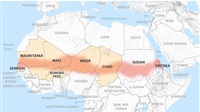Multitude of mullah misfortunes: Regime stubborn as corona kills Iranians

In the case of Iran, misfortunes do not come singly, as the
country has been struck by chaos at all levels, including conflicting numbers
and official data during the corona pandemic, losing control of the security
situation, and turning the country into a group of ghost cities in conjunction
with the collapse of the health sector after the Revolutionary Guards (IRGC)
assumed management of the crisis instead of the Ministry of Health.
False victory
Despite this, President Hassan Rouhani announced that the
virus has reached its peak in some provinces and that the pandemic has started
its downward trajectory, merely reflecting his attempt to record any success
for his government. However, he surprised Iranians by saying that the virus could
remain in the country for about two full years before his government could
control the situation, contrary to what he himself had announced just two weeks
prior when he announced victory over the pandemic and that Iran had passed the spreading
stage. But in order to avoid embarrassment, government spokesman Ali Rabei said
that the president's statement was misrepresented and falsified, even though it
was published on the media website of the presidency and official agencies.
Fatal tourism
The authorities have not yet taken firm measures to prevent
the spread of the deadly virus, such as imposing a curfew on affected areas. Even
the city of Qom, from where the pandemic spread to Iran’s other thirty
provinces, has yet to have strict measures implemented.
Activists circulated videos showing the continued spread of foreign
visitors from Asian countries throughout the affected city, despite the
authorities' announcement of isolating the city and restrict movement to
prevent the spread of the virus from China.
Keeping tourism open has raised questions and criticism from
citizens, who are required by the government to stay at home while foreign
flights are still landing in the epicenter of the pandemic.
Meanwhile, parliamentarians have criticized the Ministry of
Health’s data and questioned its reliability, as they believe the numbers
reflect less than the actual number of deaths and victims.
Mashhad, another city that hosts Shiite pilgrims, also
witnessed a sharp increase in infections after a number of extremists rejected
the government's medical measures, believing that visiting the city’s religious
shrines is a cause for recovery rather than transmission.
At the same time, chaos has spread in Iranian prisons after
a number of prisoners died from the virus. Violent rebellions occurred at
Mahabad prison in Iran’s western Kurdistan province and Alund prison in Hamadan
province, as well as prisons in Tabriz, Khorramabad and Aligudarz. Dozens of
detainees also managed to escape from Saqqez prison in the Kurdistan province.
Sunday evening in Shiraz, Adel Abad prison, the country's
largest prison with more than 10,000 detainees, witnessed clashes between the
guards and detainees attempting to escape. Activists confirmed that gunfire was
heard from inside the building and that some prisoners succeeding in escaping,
despite the authorities' denial. However, Kazem Mousavi, the chief justice of
Fars province, did admit that violent clashes took place, which resulted in the
prison’s surveillance cameras being destroyed.







